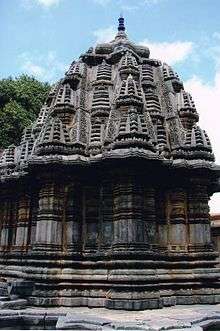Sadasiva Temple, Nuggehalli
The Sadasiva Temple was constructed in c.1249 by Bommanna Dandanayaka, a commander in the Hoysala Empire during the rule of King Vira Someshwara. It is located in Nuggehalli, (also spelled "Nuggihalli"), a town in the Hassan district of Karnataka, India. Located a short distance away in Nuggehalli, and built around the same time is the Lakshmi Narasimha temple. The town was called Vijaya Somanathapura in ancient times and gained importance as an agrahara (place of learning) during the time of Bommanna Dandanayaka. The Sadasiva temple is a fine example of Hoysala nagara style of architecture with Bhumija type superstructure.[1][2]
Architecture and furnishings
This unusual Hoysala temple combines ekakuta ("one superstructure and shrine") architecture with a nagara (north Indian) styled tower. The shrine's walls and the mantapa have austere appearance, with no sculptural decoration. Yet this temple is considered architecturally important.[2] The temple is built on a jagati (platform) and the building material used is Soapstone (green–chloritic schist). It has a large "linga" (the universal symbol of the god Shiva) in its sanctum and an equally large and extremely well carved Nandi in a closed hall with walls that have perforated stone windows. Also unique about this temple is the one of its kind life-size standing image of the goddess Parvati (consort of Shiva). The images of the navagraha (lit, "nine planets") facing each other is another unique feature to be noted. There are two images of the god Ganesha (son of Shiva), one outside the sanctum and the other at the entrance to the sanctum housing the goddess Parvati. In the common hall are the intricately carved independent images (not in frieze) of deities from the Hindu pantheon that are noteworthy:Chamundeshwari (the divine mother), Subramanya (a son of Shiva), Ganesha, Kala Bhairava (a version of Shiva), a set of images depicting the different incarnations (avatars) of Parvati, and Surya Narayana (a version of the god Vishnu).[3]
Gallery
 Close up of Sadashiva temple with Hoysala nagara shrine and superstructure (Hoysala adaptation of nagara style of architecture) at Nuggehalli
Close up of Sadashiva temple with Hoysala nagara shrine and superstructure (Hoysala adaptation of nagara style of architecture) at Nuggehalli- Entrance to Sadashiva temple at Nuggehalli
- Mantapa with lathe turned pillars in the Sadashiva temple at Nuggehalli
- Domical bay ceiling art in Sadashiva temple at Nuggehalli
- Decorative bay ceiling art in Sadashiva temple at Nuggehalli
- Lintel art in Sadashiva temple at Nuggehalli
- Lintel art in Sadashiva temple at Nuggehalli
- Ganesha sculpture in Sadashiva temple at Nuggehalli
References
| Wikimedia Commons has media related to Sadashiva Temple, Nuggehalli. |
- "A haven for architecture lovers". Spectrum, Deccan Herald, Tuesday, April 26, 2005. Archived from the original on 10 February 2007. Retrieved 28 November 2006.
- Foekema, Gerard (1996). A Complete Guide to Hoysala Temples. Abhinav, 1996. pp. 83–85.
- "A haven for architecture lovers". Spectrum, Deccan Herald, Tuesday, April 26, 2005. Archived from the original on 10 February 2007. Retrieved 28 November 2006.